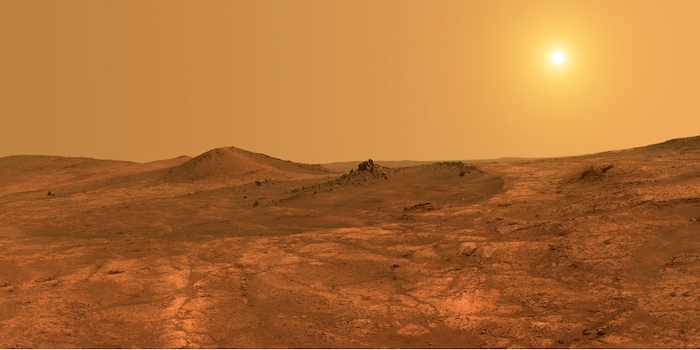
Solar energy instead of nuclear reactor on Mars
If humans were to travel to Mars, they would actually have to have a small nuclear power plant with them. But under certain circumstances, solar cells are even more effective - even though Mars gets much less sun than Earth.
Future astronauts on Mars could generate and store enough energy for their mission with the help of photovoltaic systems and hydrogen. This is the result of a study published in the journal Frontiers in Astronomy and Space Sciences. No concrete plans for a six-person Mars mission have been announced yet. However, nuclear fission has so far been considered the favored energy source for humans on Mars because a nuclear reactor produces the most energy relative to its mass. But depending on where a potential Mars base would be located on the planet, solar power could be a viable alternative to nuclear power.
For the study, researchers led by Anthony Abel of the University of California at Berkeley were guided by how much material potential astronauts would have to take with them to Mars. For nuclear power, this value is always the same, since a small reactor would not care where it was placed on Mars. The researchers calculate a "take-along mass" of 9.5 tons. Solar cells, on the other hand, face challenges similar to those on Earth: On the one hand, how much energy can be generated with photovoltaics depends on the amount of sunlight. On the other hand, the sun also sets on Mars at the end of each Martian day. That's why you need an energy store.
For its model, Abel's team looked at different configurations: nuclear power generation, photovoltaic power generation followed by storage in batteries, photovoltaic power generation followed by storage of that energy in the form of compressed hydrogen produced by electrolysis, and photoelectrochemical cells (PECs) that split water into hydrogen and oxygen and whose hydrogen could then also be stored.
Which is easier to transport: A small power plant or a photovoltaic system?
The photoelectrochemical cells, as well as the photovoltaic plant using batteries, did not prove to be more efficient than nuclear power in any case, in terms of the mass to be transported to Mars. But with solar cells that produce hydrogen through electrolysis, which could then be stored, potential astronauts would have less of a transportation problem - at least if they set up their Mars base near the Martian equator. At the equator, this entrained mass would amount to only 8.3 tons. Near the poles of Mars, however, this value rises to over 22 tons. For possible visitors to Mars, the "lighter" nuclear power is recommended.
In their model of the efficiency of the various methods, the researchers thus take into account the different regions on Mars with their different light conditions, as well as the fact that on Mars the light is mainly scattered by dust and not by water molecules as on Earth in the near infrared range. What is missing from their analysis, however, is the weather: On Mars, there are global sandstorms, sometimes lasting months, during which little light would reach any solar collectors.
Spectrum of Science
We are partner of Spektrum der Wissenschaft and want to make well-founded information more accessible to you. Follow Spektrum der Wissenschaft if you like the articles.
Originalartikel auf Spektrum.deTitelbild: Shutterstock
Experts from science and research report on the latest findings in their fields – competent, authentic and comprehensible.